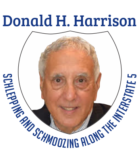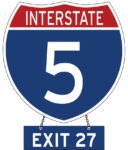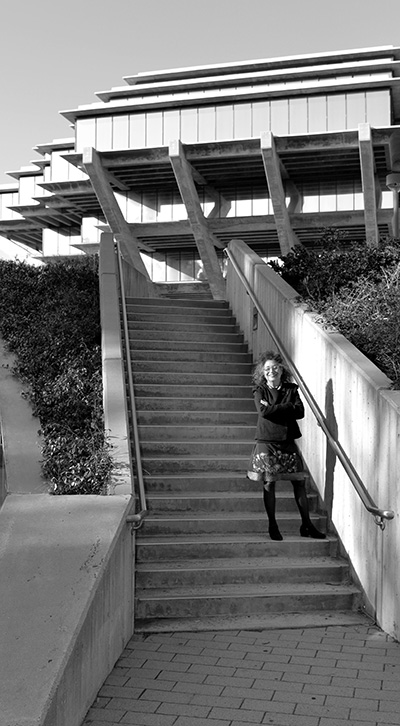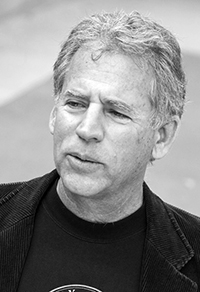Editor’s Note: This is the eleventh chapter in Volume 2 of Editor Emeritus Donald H. Harrison’s 2022 trilogy: “Schlepping and Schmoozing Along the Interstate 5.” All three books may be purchased from Amazon.com. Harrison may be contacted via donald.harrison@sdjewishworld.com
Schlepping and Schmoozing Along the Interstate 5, Exit 27 (Gilman Drive): UCSD Jewish Studies Program
From the northbound Interstate 5, take the Gilman Avenue exit and turn left. Follow to the UC San Diego campus. Its central address is 9500 Gilman Drive.
 LA JOLLA, California — Deborah Hertz, a UC San Diego historian who holds the Herman Wouk Chair in Modern Jewish Studies, has focused in her career on Jewish women who broke free of the bonds of “daughter, wife, and mother” and made their marks in a variety of fields.
LA JOLLA, California — Deborah Hertz, a UC San Diego historian who holds the Herman Wouk Chair in Modern Jewish Studies, has focused in her career on Jewish women who broke free of the bonds of “daughter, wife, and mother” and made their marks in a variety of fields.
 Inspired by the writings of historian Hannah Arendt, Prof. Hertz dug deeply into the lives of such women as Rahel Levin Varnhagen, Dorothea Mendelssohn Schlegel, and Henriette de Lemos Herz – all of whom hosted intellectual salons in Berlin during the late eighteenth and early nineteenth centuries.
Inspired by the writings of historian Hannah Arendt, Prof. Hertz dug deeply into the lives of such women as Rahel Levin Varnhagen, Dorothea Mendelssohn Schlegel, and Henriette de Lemos Herz – all of whom hosted intellectual salons in Berlin during the late eighteenth and early nineteenth centuries.
Schlegel was the daughter of Moses Mendelssohn, a decisive figure in the early Jewish Enlightenment Movement, or Haskalah. That movement promoted liberal inquiry into Jewish laws and traditions as well as integration into overall European society. Schlegel took the notion of integration beyond the bounds her father advocated. She separated from and later divorced her Jewish husband, having an affair with German literary critic and historic Friedrich Shlegel, whom she later married. She subsequently converted to his Lutheran religion and later converted again, with him, to Catholicism.
Lucinde, a novelized account by her second husband of their affair, in 1799 scandalized Berlin society, which deemed it too sexual. Under her husband’s name, Dorothea wrote Florentin, a far less spicy romantic novel that involved a love triangle among a young man offered accommodations by a well-to-do family, their daughter, and their daughter’s fiancé.
Some of the other women in the Berlin salon also abandoned their Jewish faith. Rahel Levin Varnhagen, about whom Arnedt wrote a biography in 1957, changed her surname from Levin to Robert and subsequently converted to Christianity. She reportedly had grown weary of feeling that as a Jew she always had to prove herself. She became a Christian at the time of her marriage to Karl August Varnhagen von Ense.
A third member of the salon was Henriette de Lemos Herz, who, among other accomplishments, taught Hebrew to the inveterate world traveler and geographer Alexander von Humboldt. Her “student” was befriended by President Thomas Jefferson. Humboldt County in California was among many places named for him.

Hertz’s interest in what motivated these women is reflected in two of her books published by the Yale University Press: Jewish High Society in Old Regime Berlin (1995) and How Jews Became Germans: The History of Conversion and Assimilation in Berlin (2007). Hertz, anticipating a sabbatical over the 2022-2023 academic year, planned to put finishing touches on another book which expands on the theme: Visionaries, Lovers and Mothers: Radical Jewish Women from Conspiracy to Kibbutz.
If I were a student in search of a subject for a doctoral dissertation, I would give serious consideration to writing about five generations of Hertz’s family who lived in St. Paul, Minnesota. Her double-great grandfather Aaron Mark reportedly is the namesake of the venerable Conservative congregation, The Temple of Aaron. That congregation was established in 1910 by a group of old-world Jews who were concerned that left untutored in America, their children might someday abandon their Judaism. Though Aaron was given credit for organizing the synagogue, “his wife Bessie probably did all the work,” Hertz speculated.
Another part of her paternal family included immigrants from Latvia, including great-grandfather David Blumenthal, who owned a dry goods store. In the back room he wrote a novel that was a roman-a-clef. Members of that branch of the family were cattle dealers. “The meat industry was an important part of the family’s economic history,” Hertz said.
The professor’s mother, Lorraine, an active member of Hadassah, taught at a Jewish nursery school and had a master’s degree as well as a doctorate in education – a link in a chain characterized by a “strong maternal intellectual tradition.”
During World War II, her father Marcus “Mark” Hertz, served as a navigator on a plane of the 100th Bomb Group, a unit nicknamed the “Bloody Hundred” because of its high number of losses. He was shot down on July 29, 1944. His parachute landed in a tree and after freeing himself he tried to elude capture for several days before civilians locked him into a cellar and turned him over to the German military. He was sent to Stalag Luft III at Sagan, Germany, where he stayed until Soviet troops neared the POW camp. Forced to march for nearly three months, he finally was liberated in April 1945 by elements of the U.S. Army serving under General George Patton. Although the Army Air Corps reported him “Missing in Action,” Deborah’s mother never stopped believing correctly that he remained alive.
With such a background, it’s not surprising that young Deborah “loved Jewish history.” She attended Camp Herzl and Camp Ramah in Wisconsin, was an avid Jewish folk dancer, was active in the United Synagogue Youth movement of Conservative Judaism, and she attended Hebrew Talmud Torah four times a week. A self-described “Jewish nerd,” she was inspired by Rabbi Bernard Raskas of the Temple of Aaron to “have a bat mitzvah in 1962, which was pretty controversial inside of Conservative Judaism.”
Hertz spent the first two years as an undergraduate at New York University, then studied abroad at the Hebrew University of Jerusalem—an experience she described as formative. Four professors, who were scholars of modern European history, “were astonishing.” Along with her discovery of works by Hannah Arendt, “that set the course for my research for decades,” Hertz said. “I have been doing German, Jewish, and Women’s history for about 50 years.”
For her senior year, Hertz transferred to the University of Minnesota, earning her bachelor’s degree, summa cum laude in 1971. A master’s degree came three years later, and her doctorate in 1979. While earning her Ph.D., Hertz lived in Berlin for a few years, “researching, meeting other scholars, and improving my German.”
She went on to a distinguished academic career, including a year as an Andrew W. Mellon Faculty Fellow in the Humanities at Harvard University, and another as a Fulbright Professor at the Hebrew University. She also taught at the University of Haifa, the State University of New York at Binghamton, Tel Aviv University, Sarah Lawrence College, and in 2004, she came to UC San Diego.
When she joined the UC San Diego faculty as a scholar of Modern European History, the Jewish Studies Program was known principally for its expertise in Biblical Studies. Chairing the program was Biblical Scholar Richard Elliott Friedman, who was joined by David Noel Freedman, editor of the Anchor Bible Series, and William Propp, whose Biblical expertise included the Book of Exodus. Richard Elliott Friedman became widely known and admired for his book Who Wrote the Bible? It cogently presented the Documentary Thesis – that the Bible was written by different authors at different times and was subsequently collated. David Noel Freedman, a Jew by birth, like Dorothea Mendelssohn Schlegel converted to Christianity, in fact becoming ordained as a Protestant minister.

Along with this trio was archaeologist Thomas Levy, who remains at UC San Diego whereas Friedman left for the University of Georgia, Freedman died after retiring, and Propp is retired. Levy leads field expositions to Israel and other parts of the Middle East. He is acknowledged as a leader in the field of Israelite and Biblical archaeology, with many of his students having gone on to teaching positions at other universities, Hertz commented admiringly.
Hertz served as the director of the Jewish Studies Program from 2013 to 2015 but since then other faculty members such as Literature Professors Amelia Glaser and Lisa Lampert-Weissig have taken their turns.
Levy, Lamper-Wiessig, Glaser, History Prof. Mira Balberg, and Hertz are the core professors in the Jewish Studies Program, with as many as 10 other professors from various academic departments offering courses that count towards a Jewish Studies major or minor.
Students of varying religious backgrounds are attracted to Jewish Studies courses, depending upon the subject being offered, Hertz said. While self-identified Jewish students may predominate in some of the more Judeocentric courses, others like those taught by Hertz about the Holocaust draws majorities of non-Jewish students.
She commented that Jewish Studies on the West Coast are different from those on the East Coast. At Brandeis University in Massachusetts, for example, there are classes in the Torah and Talmud as well as the Aramaic language in which some Scripture was written.
Hertz was 73 when interviewed in February 2022. Hertz said her path in academia, “has been generously supported” by her husband Martin Bunzl, professor emeritus at Rutgers University. They are the parents of two grown children and five grandchildren. Hertz jokes that she plans to keep teaching and that she will “die in the classroom.”
*
Donald H. Harrison is editor emeritus of San Diego Jewish World. He may be contacted via donald.harrison@sdjewishworld.com